University Report: MGT603 System Thinking Analysis of Emergency Room
VerifiedAdded on 2022/11/24
|13
|2693
|330
Report
AI Summary
This report, prepared for a university course, applies system thinking principles to analyze and improve the efficiency of an emergency room. The report begins with an executive summary and table of contents, setting the stage for an in-depth exploration of system archetypes and their application. It identifies and analyzes various system archetypes relevant to healthcare settings, using circles of causality to illustrate the dynamics of the system. A current state value stream map of the emergency room is presented, highlighting the significant wait times experienced by patients. The report then proposes a new state value stream map designed to reduce these wait times and improve patient care. The intended and unintended consequences of the proposed changes are discussed, followed by recommendations for implementation. The report concludes by emphasizing the importance of system thinking in optimizing healthcare processes and ensuring patient satisfaction. The analysis includes a review of the key components of the emergency room process, such as patient registration, examination by nurses and doctors, and the preparation of medical reports, with a focus on streamlining these processes to minimize waiting times. The report also underscores the benefits of proactive planning and effective communication within the organization.
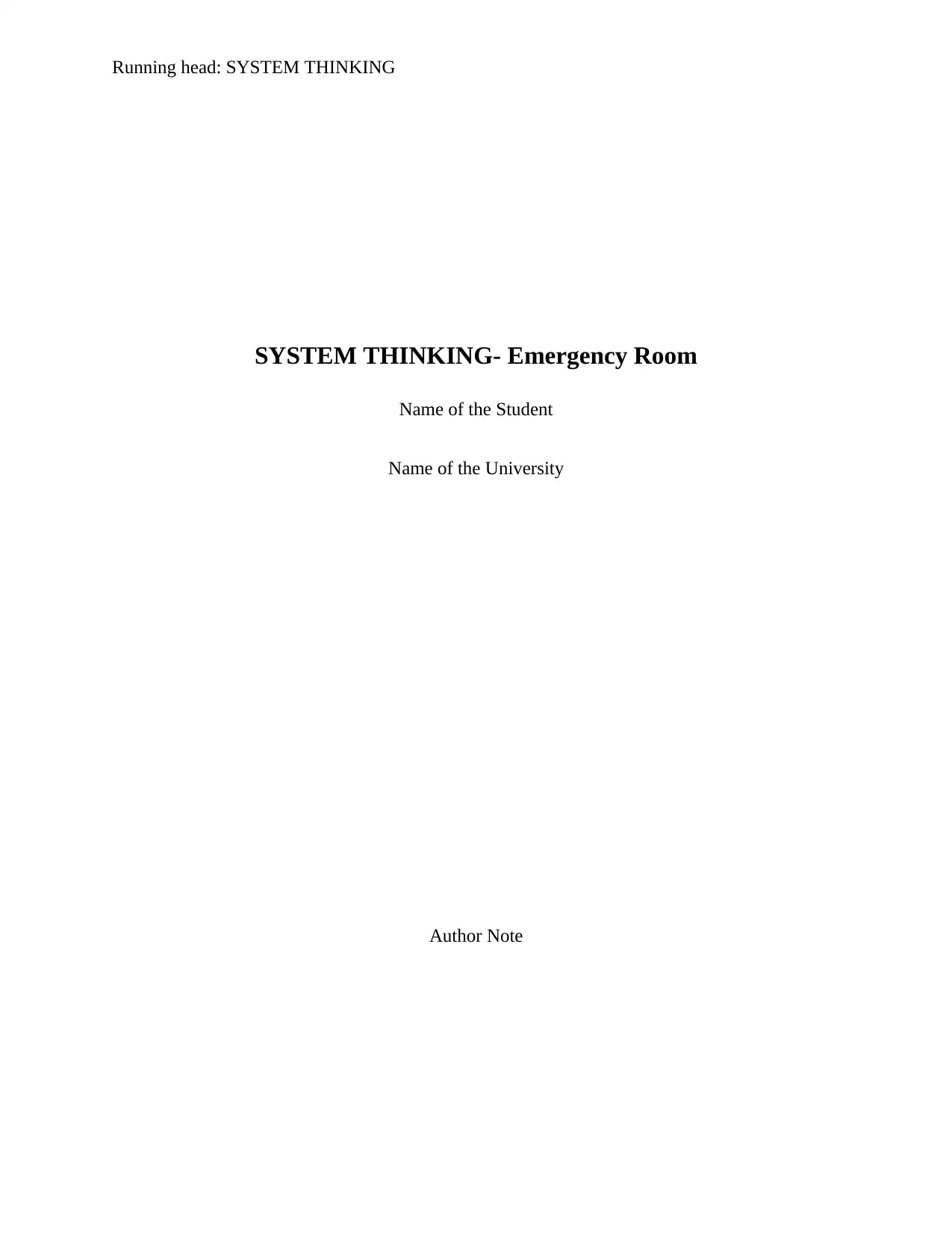
Running head: SYSTEM THINKING
SYSTEM THINKING- Emergency Room
Name of the Student
Name of the University
Author Note
SYSTEM THINKING- Emergency Room
Name of the Student
Name of the University
Author Note
Paraphrase This Document
Need a fresh take? Get an instant paraphrase of this document with our AI Paraphraser
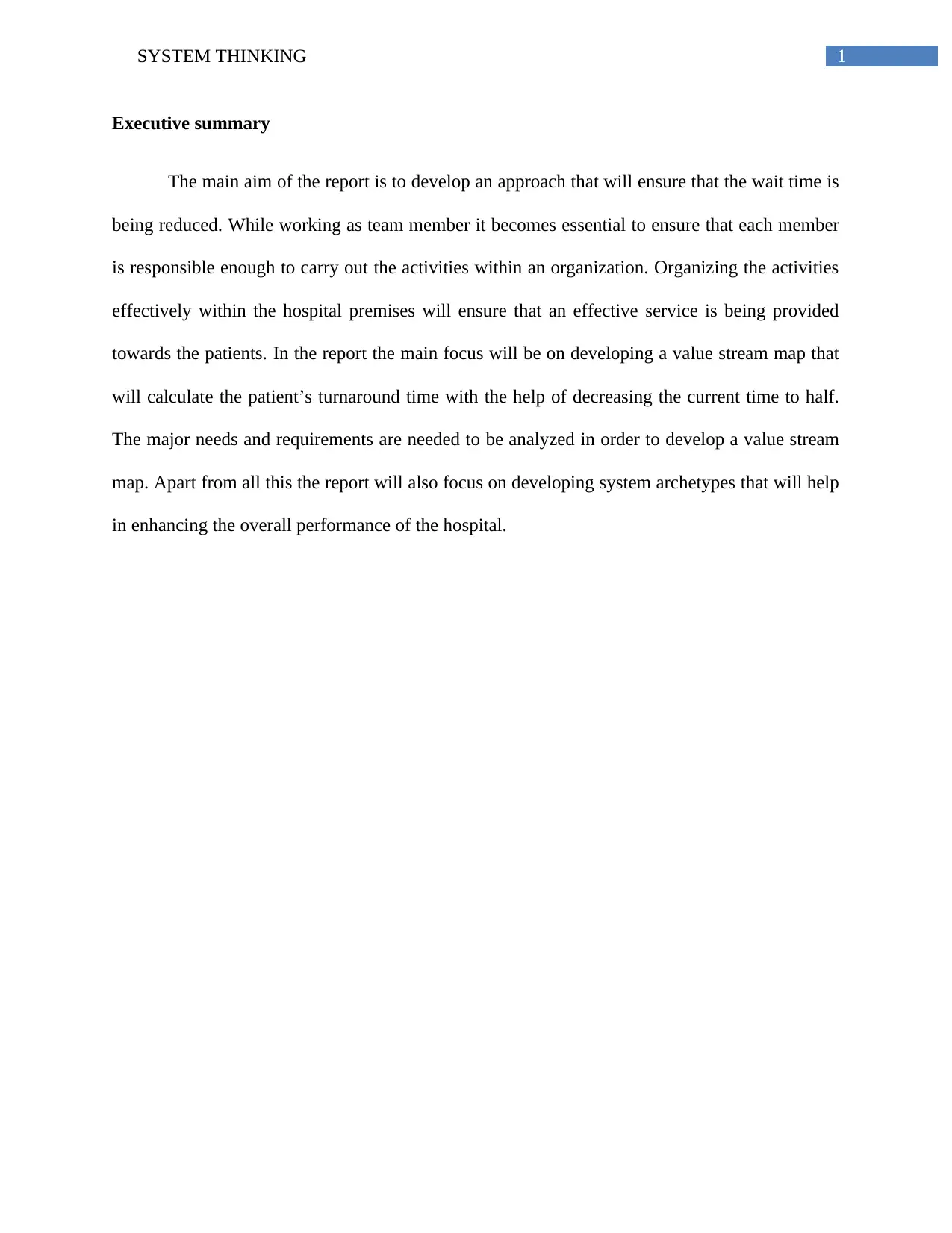
1SYSTEM THINKING
Executive summary
The main aim of the report is to develop an approach that will ensure that the wait time is
being reduced. While working as team member it becomes essential to ensure that each member
is responsible enough to carry out the activities within an organization. Organizing the activities
effectively within the hospital premises will ensure that an effective service is being provided
towards the patients. In the report the main focus will be on developing a value stream map that
will calculate the patient’s turnaround time with the help of decreasing the current time to half.
The major needs and requirements are needed to be analyzed in order to develop a value stream
map. Apart from all this the report will also focus on developing system archetypes that will help
in enhancing the overall performance of the hospital.
Executive summary
The main aim of the report is to develop an approach that will ensure that the wait time is
being reduced. While working as team member it becomes essential to ensure that each member
is responsible enough to carry out the activities within an organization. Organizing the activities
effectively within the hospital premises will ensure that an effective service is being provided
towards the patients. In the report the main focus will be on developing a value stream map that
will calculate the patient’s turnaround time with the help of decreasing the current time to half.
The major needs and requirements are needed to be analyzed in order to develop a value stream
map. Apart from all this the report will also focus on developing system archetypes that will help
in enhancing the overall performance of the hospital.
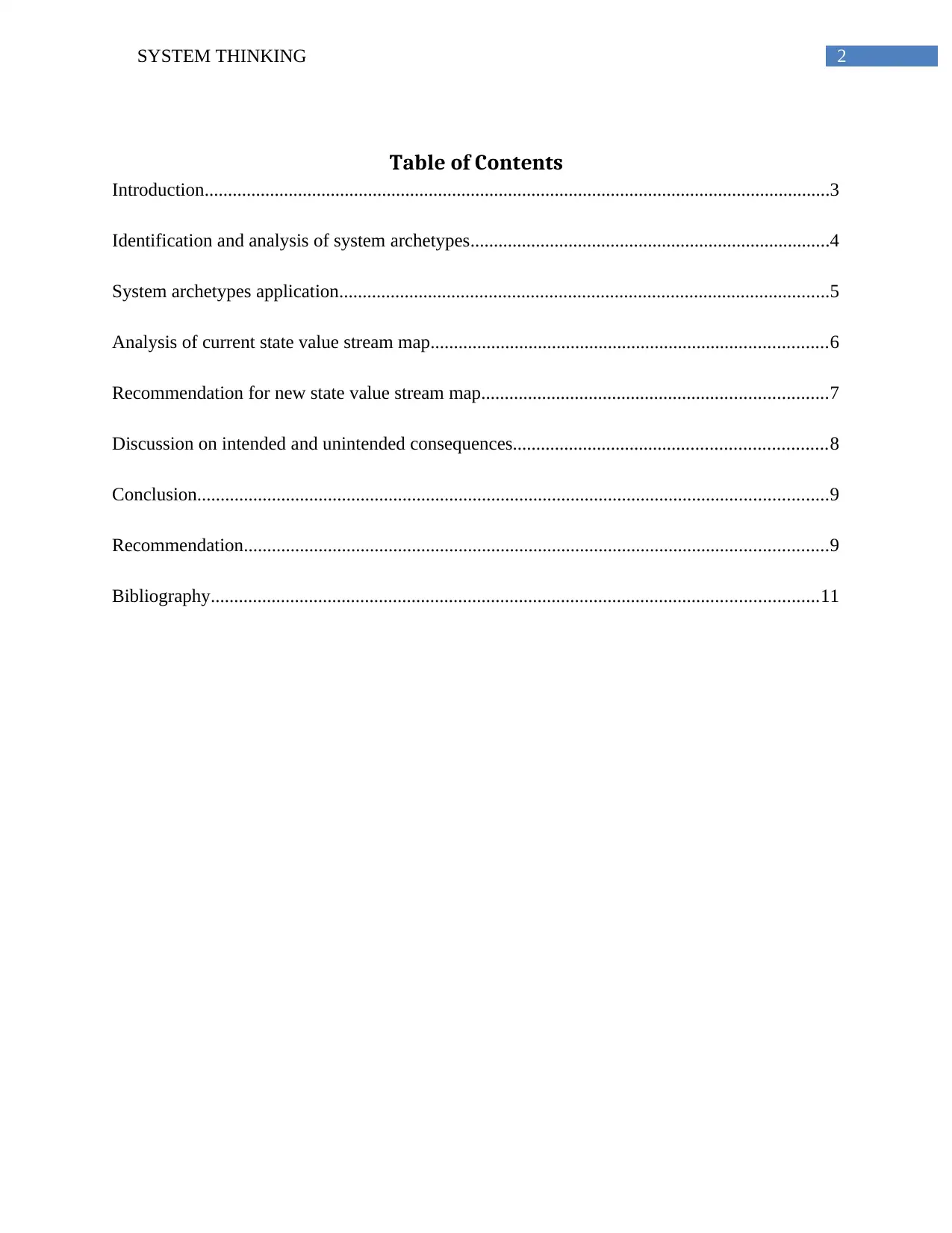
2SYSTEM THINKING
Table of Contents
Introduction......................................................................................................................................3
Identification and analysis of system archetypes.............................................................................4
System archetypes application.........................................................................................................5
Analysis of current state value stream map.....................................................................................6
Recommendation for new state value stream map..........................................................................7
Discussion on intended and unintended consequences...................................................................8
Conclusion.......................................................................................................................................9
Recommendation.............................................................................................................................9
Bibliography..................................................................................................................................11
Table of Contents
Introduction......................................................................................................................................3
Identification and analysis of system archetypes.............................................................................4
System archetypes application.........................................................................................................5
Analysis of current state value stream map.....................................................................................6
Recommendation for new state value stream map..........................................................................7
Discussion on intended and unintended consequences...................................................................8
Conclusion.......................................................................................................................................9
Recommendation.............................................................................................................................9
Bibliography..................................................................................................................................11
⊘ This is a preview!⊘
Do you want full access?
Subscribe today to unlock all pages.

Trusted by 1+ million students worldwide
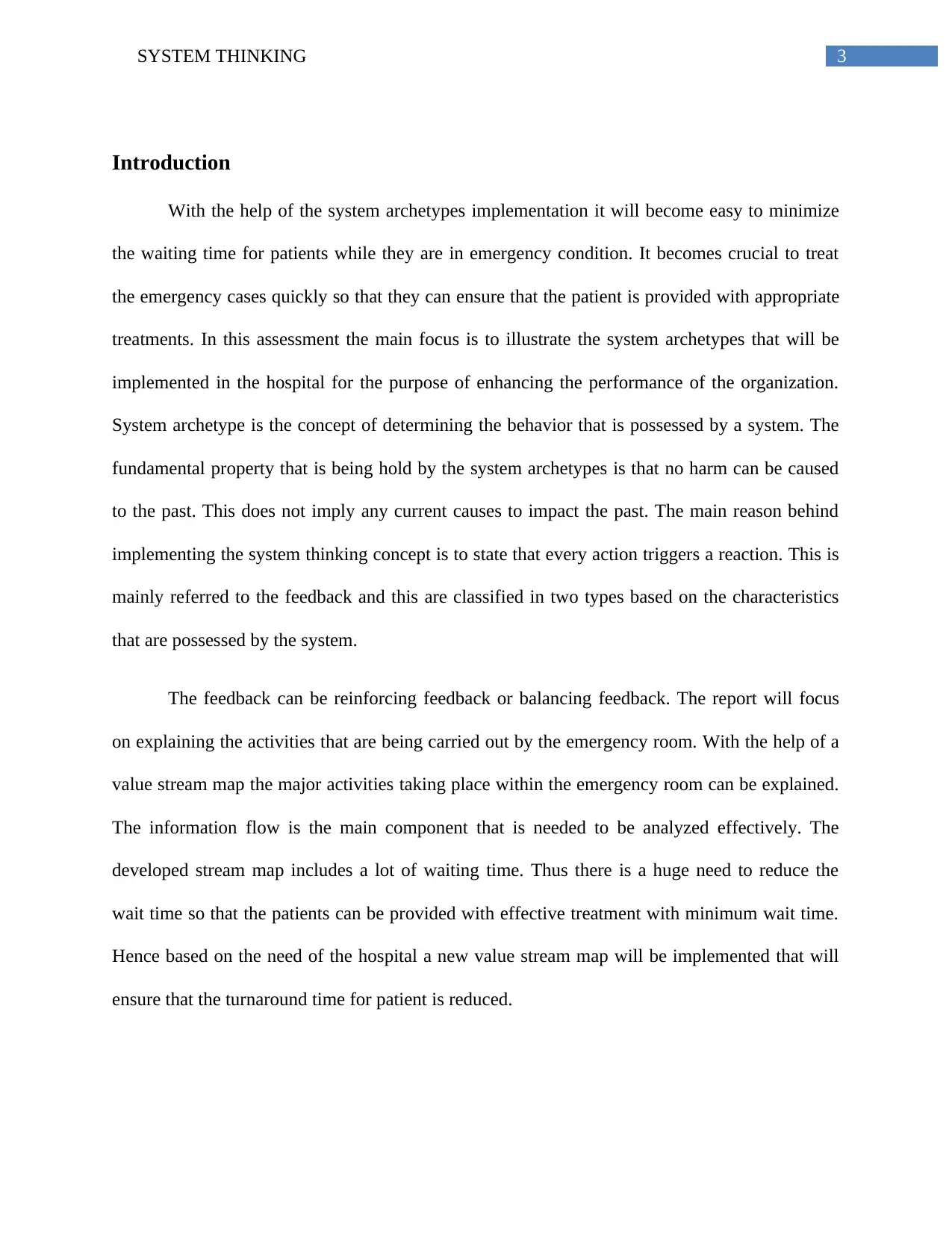
3SYSTEM THINKING
Introduction
With the help of the system archetypes implementation it will become easy to minimize
the waiting time for patients while they are in emergency condition. It becomes crucial to treat
the emergency cases quickly so that they can ensure that the patient is provided with appropriate
treatments. In this assessment the main focus is to illustrate the system archetypes that will be
implemented in the hospital for the purpose of enhancing the performance of the organization.
System archetype is the concept of determining the behavior that is possessed by a system. The
fundamental property that is being hold by the system archetypes is that no harm can be caused
to the past. This does not imply any current causes to impact the past. The main reason behind
implementing the system thinking concept is to state that every action triggers a reaction. This is
mainly referred to the feedback and this are classified in two types based on the characteristics
that are possessed by the system.
The feedback can be reinforcing feedback or balancing feedback. The report will focus
on explaining the activities that are being carried out by the emergency room. With the help of a
value stream map the major activities taking place within the emergency room can be explained.
The information flow is the main component that is needed to be analyzed effectively. The
developed stream map includes a lot of waiting time. Thus there is a huge need to reduce the
wait time so that the patients can be provided with effective treatment with minimum wait time.
Hence based on the need of the hospital a new value stream map will be implemented that will
ensure that the turnaround time for patient is reduced.
Introduction
With the help of the system archetypes implementation it will become easy to minimize
the waiting time for patients while they are in emergency condition. It becomes crucial to treat
the emergency cases quickly so that they can ensure that the patient is provided with appropriate
treatments. In this assessment the main focus is to illustrate the system archetypes that will be
implemented in the hospital for the purpose of enhancing the performance of the organization.
System archetype is the concept of determining the behavior that is possessed by a system. The
fundamental property that is being hold by the system archetypes is that no harm can be caused
to the past. This does not imply any current causes to impact the past. The main reason behind
implementing the system thinking concept is to state that every action triggers a reaction. This is
mainly referred to the feedback and this are classified in two types based on the characteristics
that are possessed by the system.
The feedback can be reinforcing feedback or balancing feedback. The report will focus
on explaining the activities that are being carried out by the emergency room. With the help of a
value stream map the major activities taking place within the emergency room can be explained.
The information flow is the main component that is needed to be analyzed effectively. The
developed stream map includes a lot of waiting time. Thus there is a huge need to reduce the
wait time so that the patients can be provided with effective treatment with minimum wait time.
Hence based on the need of the hospital a new value stream map will be implemented that will
ensure that the turnaround time for patient is reduced.
Paraphrase This Document
Need a fresh take? Get an instant paraphrase of this document with our AI Paraphraser
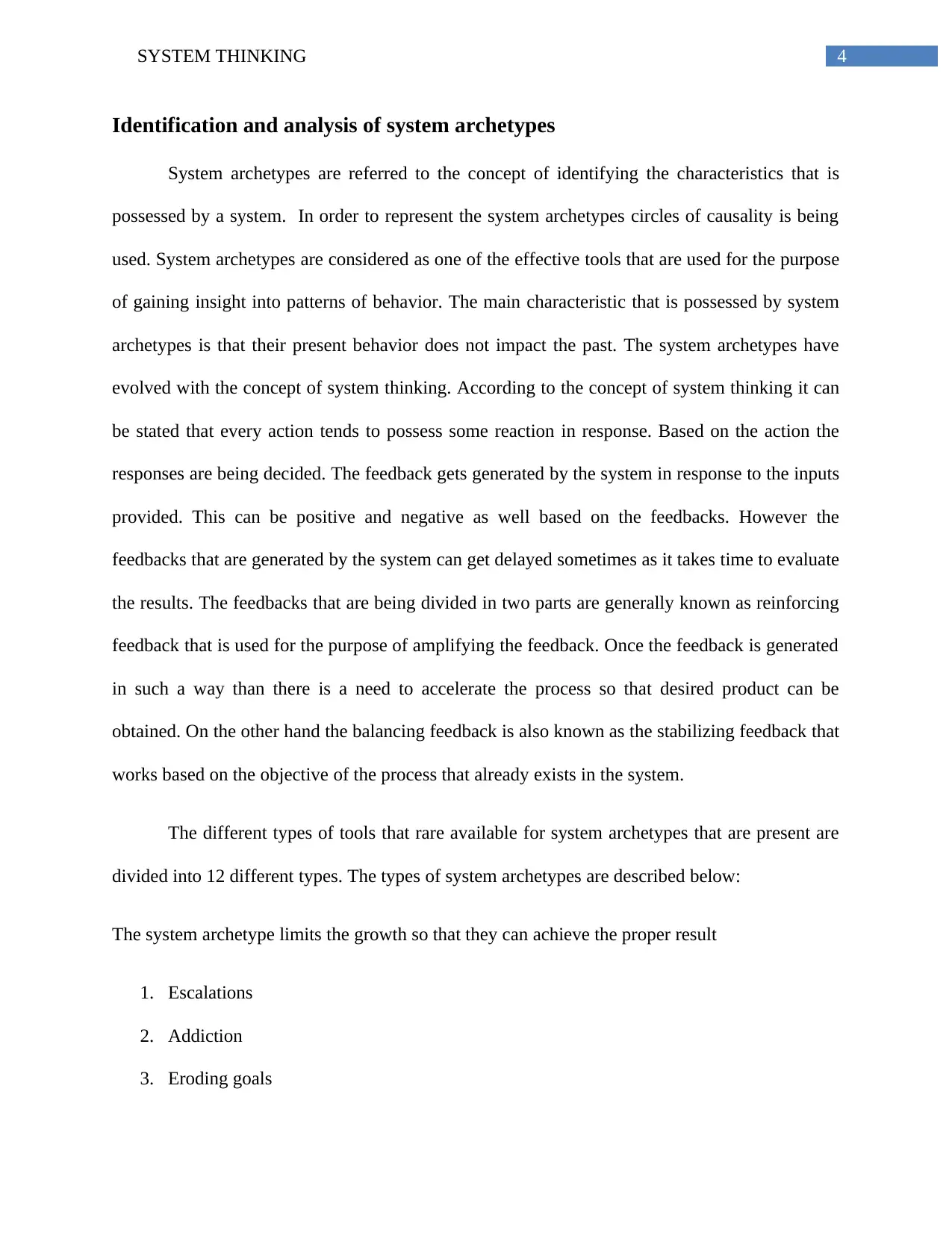
4SYSTEM THINKING
Identification and analysis of system archetypes
System archetypes are referred to the concept of identifying the characteristics that is
possessed by a system. In order to represent the system archetypes circles of causality is being
used. System archetypes are considered as one of the effective tools that are used for the purpose
of gaining insight into patterns of behavior. The main characteristic that is possessed by system
archetypes is that their present behavior does not impact the past. The system archetypes have
evolved with the concept of system thinking. According to the concept of system thinking it can
be stated that every action tends to possess some reaction in response. Based on the action the
responses are being decided. The feedback gets generated by the system in response to the inputs
provided. This can be positive and negative as well based on the feedbacks. However the
feedbacks that are generated by the system can get delayed sometimes as it takes time to evaluate
the results. The feedbacks that are being divided in two parts are generally known as reinforcing
feedback that is used for the purpose of amplifying the feedback. Once the feedback is generated
in such a way than there is a need to accelerate the process so that desired product can be
obtained. On the other hand the balancing feedback is also known as the stabilizing feedback that
works based on the objective of the process that already exists in the system.
The different types of tools that rare available for system archetypes that are present are
divided into 12 different types. The types of system archetypes are described below:
The system archetype limits the growth so that they can achieve the proper result
1. Escalations
2. Addiction
3. Eroding goals
Identification and analysis of system archetypes
System archetypes are referred to the concept of identifying the characteristics that is
possessed by a system. In order to represent the system archetypes circles of causality is being
used. System archetypes are considered as one of the effective tools that are used for the purpose
of gaining insight into patterns of behavior. The main characteristic that is possessed by system
archetypes is that their present behavior does not impact the past. The system archetypes have
evolved with the concept of system thinking. According to the concept of system thinking it can
be stated that every action tends to possess some reaction in response. Based on the action the
responses are being decided. The feedback gets generated by the system in response to the inputs
provided. This can be positive and negative as well based on the feedbacks. However the
feedbacks that are generated by the system can get delayed sometimes as it takes time to evaluate
the results. The feedbacks that are being divided in two parts are generally known as reinforcing
feedback that is used for the purpose of amplifying the feedback. Once the feedback is generated
in such a way than there is a need to accelerate the process so that desired product can be
obtained. On the other hand the balancing feedback is also known as the stabilizing feedback that
works based on the objective of the process that already exists in the system.
The different types of tools that rare available for system archetypes that are present are
divided into 12 different types. The types of system archetypes are described below:
The system archetype limits the growth so that they can achieve the proper result
1. Escalations
2. Addiction
3. Eroding goals
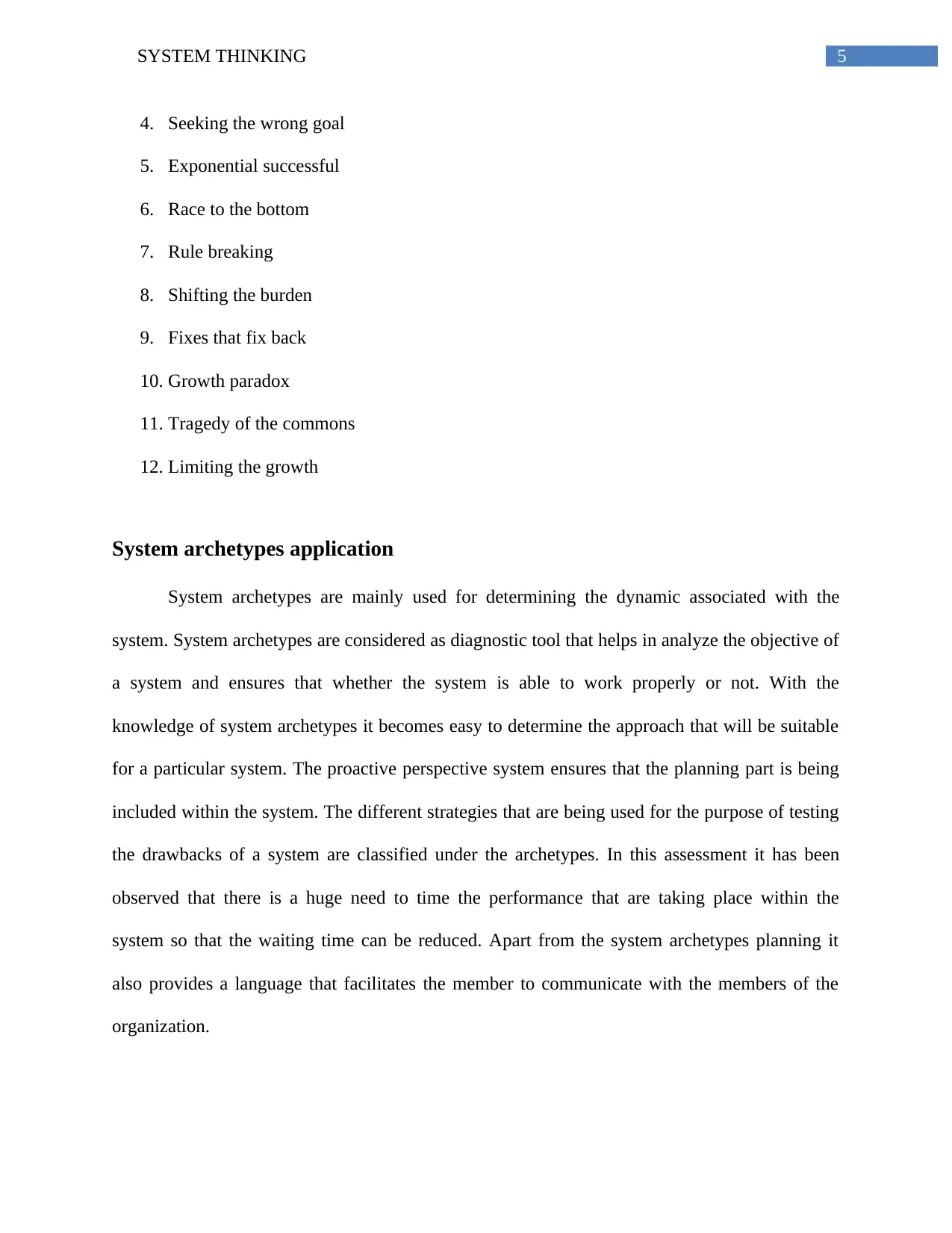
5SYSTEM THINKING
4. Seeking the wrong goal
5. Exponential successful
6. Race to the bottom
7. Rule breaking
8. Shifting the burden
9. Fixes that fix back
10. Growth paradox
11. Tragedy of the commons
12. Limiting the growth
System archetypes application
System archetypes are mainly used for determining the dynamic associated with the
system. System archetypes are considered as diagnostic tool that helps in analyze the objective of
a system and ensures that whether the system is able to work properly or not. With the
knowledge of system archetypes it becomes easy to determine the approach that will be suitable
for a particular system. The proactive perspective system ensures that the planning part is being
included within the system. The different strategies that are being used for the purpose of testing
the drawbacks of a system are classified under the archetypes. In this assessment it has been
observed that there is a huge need to time the performance that are taking place within the
system so that the waiting time can be reduced. Apart from the system archetypes planning it
also provides a language that facilitates the member to communicate with the members of the
organization.
4. Seeking the wrong goal
5. Exponential successful
6. Race to the bottom
7. Rule breaking
8. Shifting the burden
9. Fixes that fix back
10. Growth paradox
11. Tragedy of the commons
12. Limiting the growth
System archetypes application
System archetypes are mainly used for determining the dynamic associated with the
system. System archetypes are considered as diagnostic tool that helps in analyze the objective of
a system and ensures that whether the system is able to work properly or not. With the
knowledge of system archetypes it becomes easy to determine the approach that will be suitable
for a particular system. The proactive perspective system ensures that the planning part is being
included within the system. The different strategies that are being used for the purpose of testing
the drawbacks of a system are classified under the archetypes. In this assessment it has been
observed that there is a huge need to time the performance that are taking place within the
system so that the waiting time can be reduced. Apart from the system archetypes planning it
also provides a language that facilitates the member to communicate with the members of the
organization.
⊘ This is a preview!⊘
Do you want full access?
Subscribe today to unlock all pages.

Trusted by 1+ million students worldwide
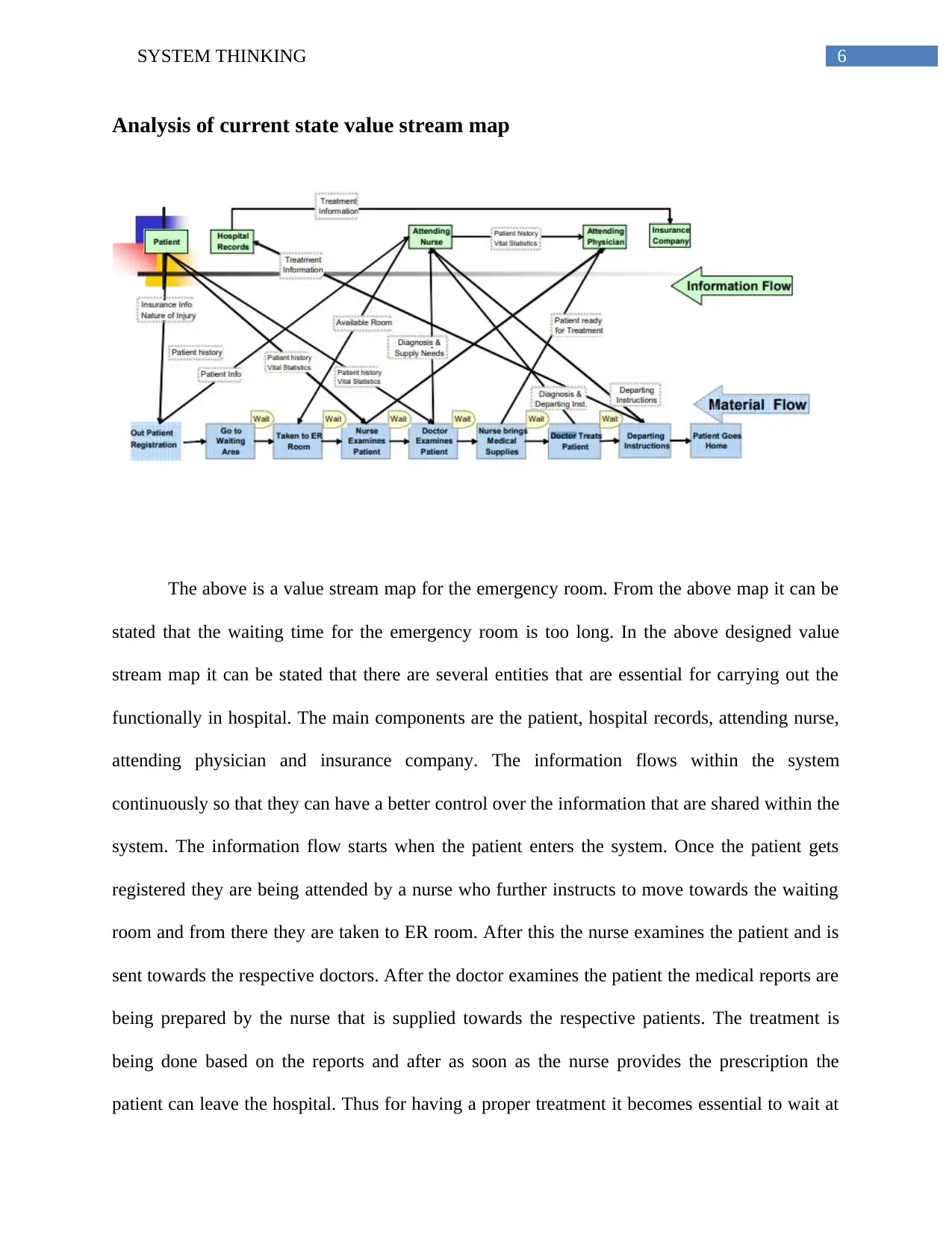
6SYSTEM THINKING
Analysis of current state value stream map
The above is a value stream map for the emergency room. From the above map it can be
stated that the waiting time for the emergency room is too long. In the above designed value
stream map it can be stated that there are several entities that are essential for carrying out the
functionally in hospital. The main components are the patient, hospital records, attending nurse,
attending physician and insurance company. The information flows within the system
continuously so that they can have a better control over the information that are shared within the
system. The information flow starts when the patient enters the system. Once the patient gets
registered they are being attended by a nurse who further instructs to move towards the waiting
room and from there they are taken to ER room. After this the nurse examines the patient and is
sent towards the respective doctors. After the doctor examines the patient the medical reports are
being prepared by the nurse that is supplied towards the respective patients. The treatment is
being done based on the reports and after as soon as the nurse provides the prescription the
patient can leave the hospital. Thus for having a proper treatment it becomes essential to wait at
Analysis of current state value stream map
The above is a value stream map for the emergency room. From the above map it can be
stated that the waiting time for the emergency room is too long. In the above designed value
stream map it can be stated that there are several entities that are essential for carrying out the
functionally in hospital. The main components are the patient, hospital records, attending nurse,
attending physician and insurance company. The information flows within the system
continuously so that they can have a better control over the information that are shared within the
system. The information flow starts when the patient enters the system. Once the patient gets
registered they are being attended by a nurse who further instructs to move towards the waiting
room and from there they are taken to ER room. After this the nurse examines the patient and is
sent towards the respective doctors. After the doctor examines the patient the medical reports are
being prepared by the nurse that is supplied towards the respective patients. The treatment is
being done based on the reports and after as soon as the nurse provides the prescription the
patient can leave the hospital. Thus for having a proper treatment it becomes essential to wait at
Paraphrase This Document
Need a fresh take? Get an instant paraphrase of this document with our AI Paraphraser
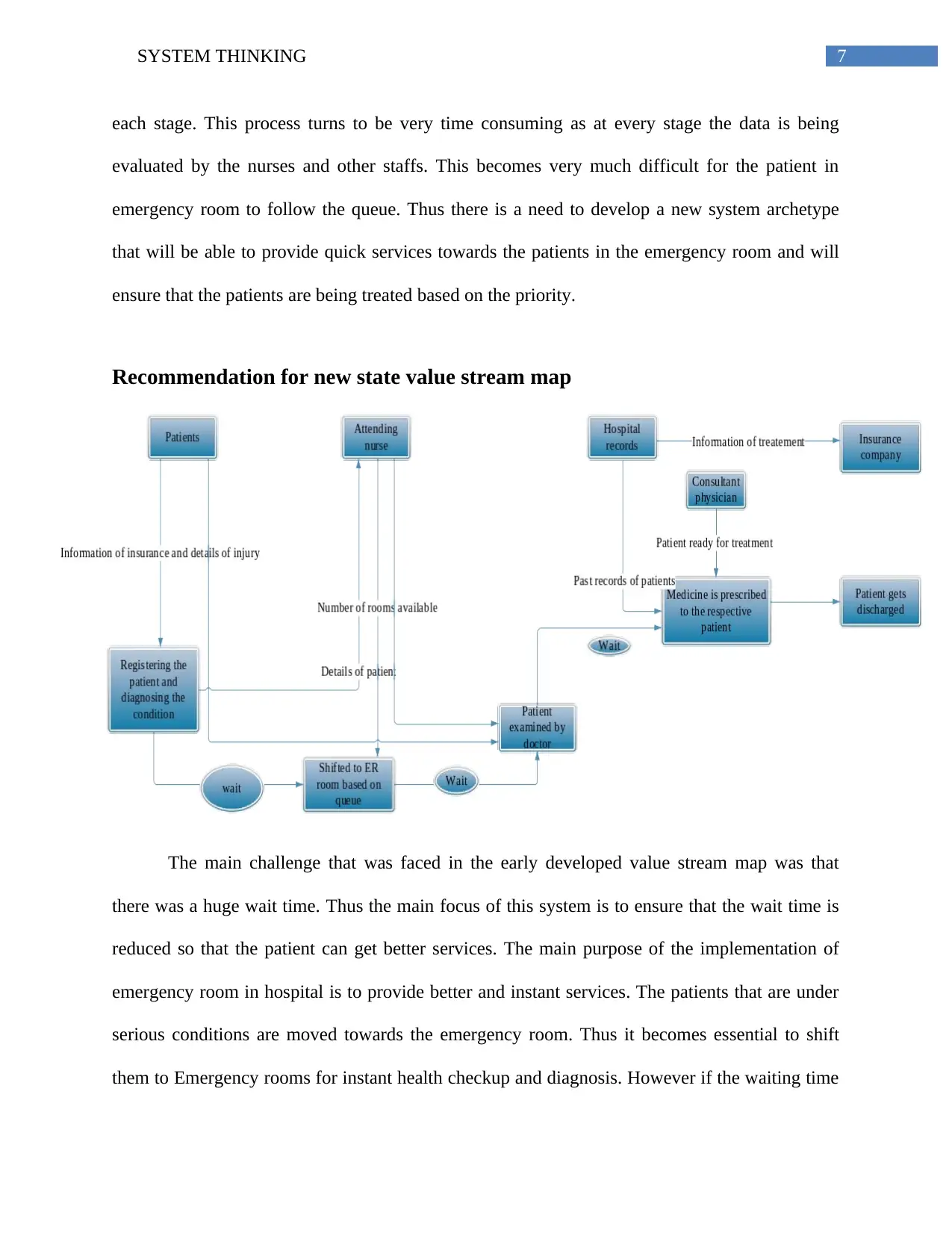
7SYSTEM THINKING
each stage. This process turns to be very time consuming as at every stage the data is being
evaluated by the nurses and other staffs. This becomes very much difficult for the patient in
emergency room to follow the queue. Thus there is a need to develop a new system archetype
that will be able to provide quick services towards the patients in the emergency room and will
ensure that the patients are being treated based on the priority.
Recommendation for new state value stream map
The main challenge that was faced in the early developed value stream map was that
there was a huge wait time. Thus the main focus of this system is to ensure that the wait time is
reduced so that the patient can get better services. The main purpose of the implementation of
emergency room in hospital is to provide better and instant services. The patients that are under
serious conditions are moved towards the emergency room. Thus it becomes essential to shift
them to Emergency rooms for instant health checkup and diagnosis. However if the waiting time
each stage. This process turns to be very time consuming as at every stage the data is being
evaluated by the nurses and other staffs. This becomes very much difficult for the patient in
emergency room to follow the queue. Thus there is a need to develop a new system archetype
that will be able to provide quick services towards the patients in the emergency room and will
ensure that the patients are being treated based on the priority.
Recommendation for new state value stream map
The main challenge that was faced in the early developed value stream map was that
there was a huge wait time. Thus the main focus of this system is to ensure that the wait time is
reduced so that the patient can get better services. The main purpose of the implementation of
emergency room in hospital is to provide better and instant services. The patients that are under
serious conditions are moved towards the emergency room. Thus it becomes essential to shift
them to Emergency rooms for instant health checkup and diagnosis. However if the waiting time
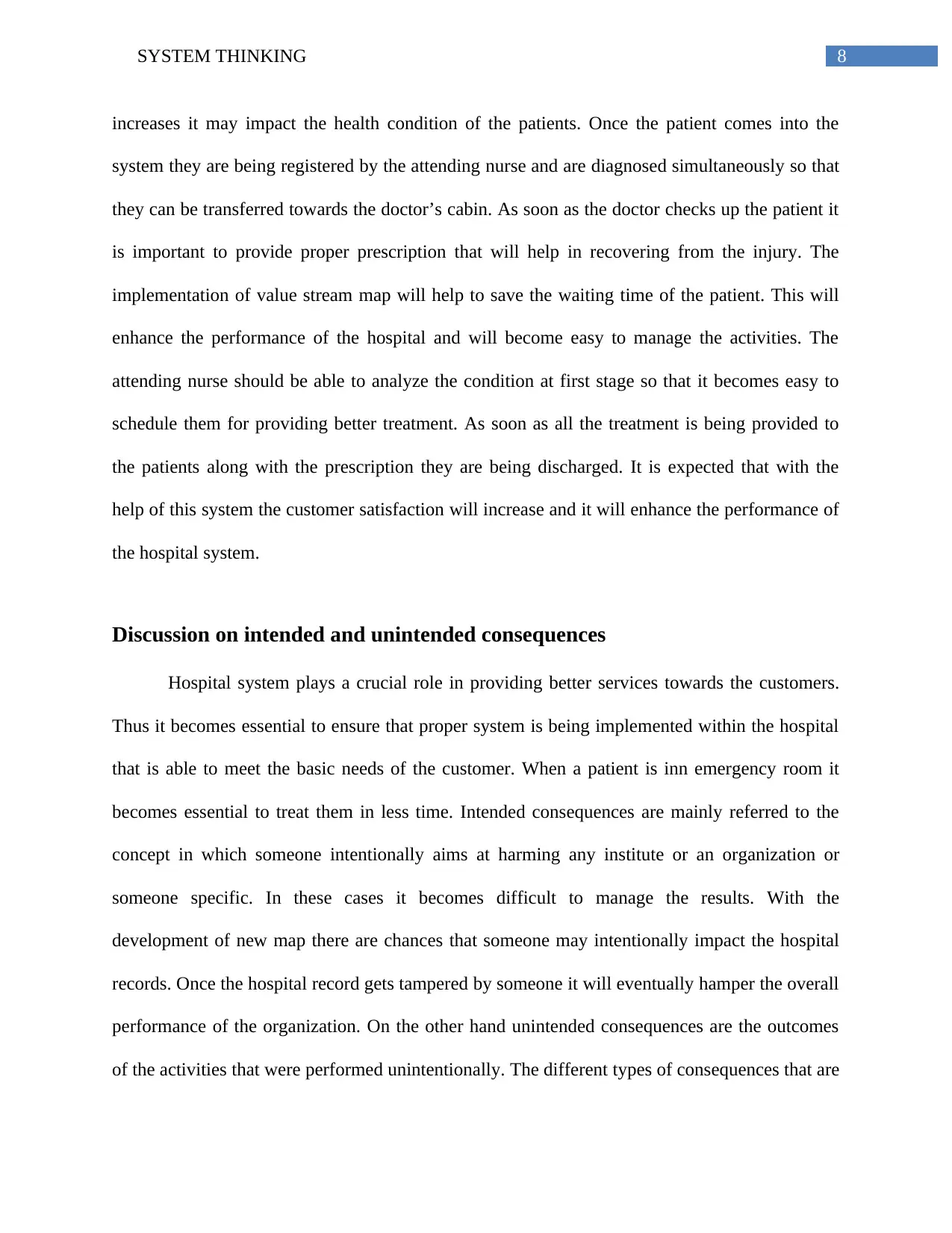
8SYSTEM THINKING
increases it may impact the health condition of the patients. Once the patient comes into the
system they are being registered by the attending nurse and are diagnosed simultaneously so that
they can be transferred towards the doctor’s cabin. As soon as the doctor checks up the patient it
is important to provide proper prescription that will help in recovering from the injury. The
implementation of value stream map will help to save the waiting time of the patient. This will
enhance the performance of the hospital and will become easy to manage the activities. The
attending nurse should be able to analyze the condition at first stage so that it becomes easy to
schedule them for providing better treatment. As soon as all the treatment is being provided to
the patients along with the prescription they are being discharged. It is expected that with the
help of this system the customer satisfaction will increase and it will enhance the performance of
the hospital system.
Discussion on intended and unintended consequences
Hospital system plays a crucial role in providing better services towards the customers.
Thus it becomes essential to ensure that proper system is being implemented within the hospital
that is able to meet the basic needs of the customer. When a patient is inn emergency room it
becomes essential to treat them in less time. Intended consequences are mainly referred to the
concept in which someone intentionally aims at harming any institute or an organization or
someone specific. In these cases it becomes difficult to manage the results. With the
development of new map there are chances that someone may intentionally impact the hospital
records. Once the hospital record gets tampered by someone it will eventually hamper the overall
performance of the organization. On the other hand unintended consequences are the outcomes
of the activities that were performed unintentionally. The different types of consequences that are
increases it may impact the health condition of the patients. Once the patient comes into the
system they are being registered by the attending nurse and are diagnosed simultaneously so that
they can be transferred towards the doctor’s cabin. As soon as the doctor checks up the patient it
is important to provide proper prescription that will help in recovering from the injury. The
implementation of value stream map will help to save the waiting time of the patient. This will
enhance the performance of the hospital and will become easy to manage the activities. The
attending nurse should be able to analyze the condition at first stage so that it becomes easy to
schedule them for providing better treatment. As soon as all the treatment is being provided to
the patients along with the prescription they are being discharged. It is expected that with the
help of this system the customer satisfaction will increase and it will enhance the performance of
the hospital system.
Discussion on intended and unintended consequences
Hospital system plays a crucial role in providing better services towards the customers.
Thus it becomes essential to ensure that proper system is being implemented within the hospital
that is able to meet the basic needs of the customer. When a patient is inn emergency room it
becomes essential to treat them in less time. Intended consequences are mainly referred to the
concept in which someone intentionally aims at harming any institute or an organization or
someone specific. In these cases it becomes difficult to manage the results. With the
development of new map there are chances that someone may intentionally impact the hospital
records. Once the hospital record gets tampered by someone it will eventually hamper the overall
performance of the organization. On the other hand unintended consequences are the outcomes
of the activities that were performed unintentionally. The different types of consequences that are
⊘ This is a preview!⊘
Do you want full access?
Subscribe today to unlock all pages.

Trusted by 1+ million students worldwide
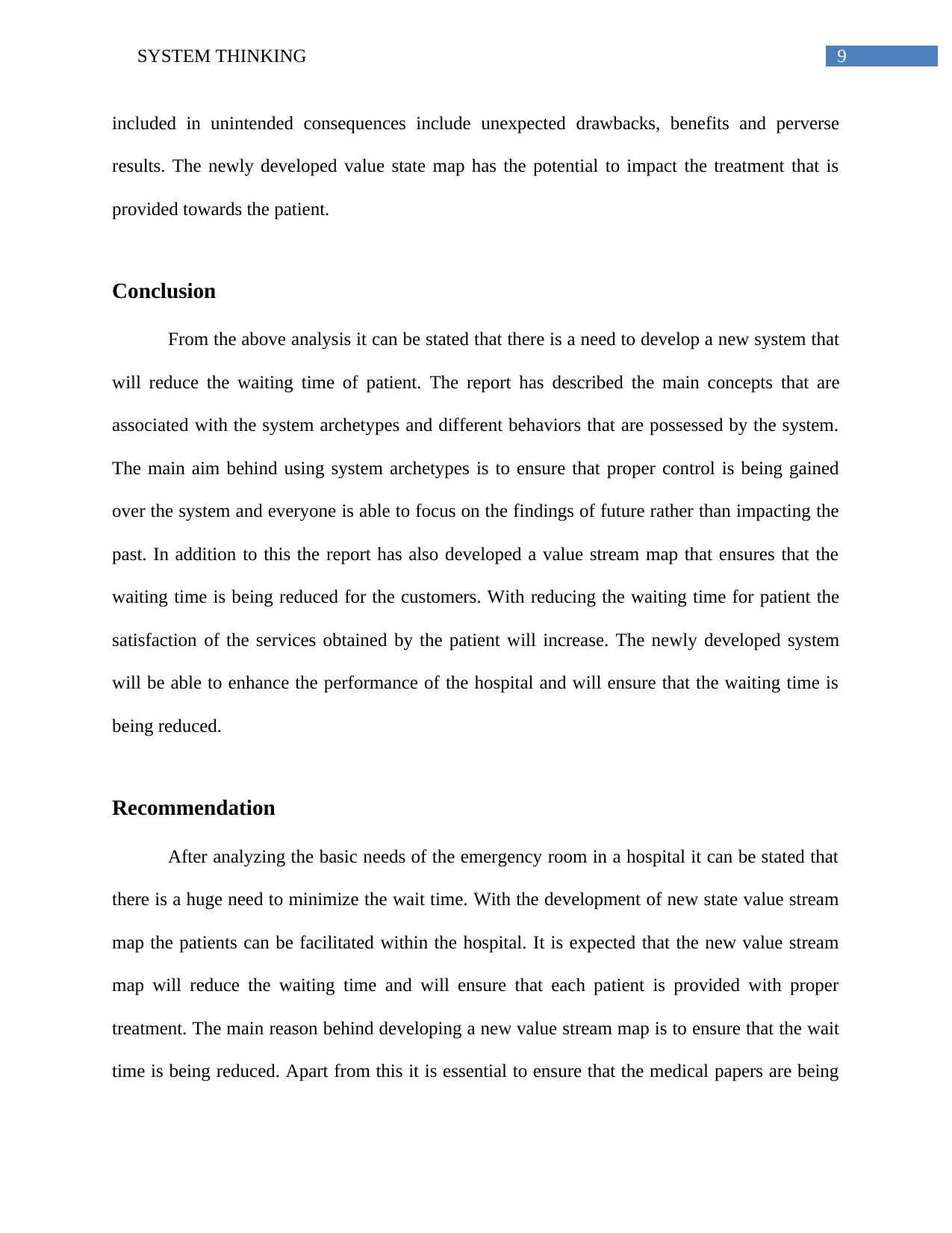
9SYSTEM THINKING
included in unintended consequences include unexpected drawbacks, benefits and perverse
results. The newly developed value state map has the potential to impact the treatment that is
provided towards the patient.
Conclusion
From the above analysis it can be stated that there is a need to develop a new system that
will reduce the waiting time of patient. The report has described the main concepts that are
associated with the system archetypes and different behaviors that are possessed by the system.
The main aim behind using system archetypes is to ensure that proper control is being gained
over the system and everyone is able to focus on the findings of future rather than impacting the
past. In addition to this the report has also developed a value stream map that ensures that the
waiting time is being reduced for the customers. With reducing the waiting time for patient the
satisfaction of the services obtained by the patient will increase. The newly developed system
will be able to enhance the performance of the hospital and will ensure that the waiting time is
being reduced.
Recommendation
After analyzing the basic needs of the emergency room in a hospital it can be stated that
there is a huge need to minimize the wait time. With the development of new state value stream
map the patients can be facilitated within the hospital. It is expected that the new value stream
map will reduce the waiting time and will ensure that each patient is provided with proper
treatment. The main reason behind developing a new value stream map is to ensure that the wait
time is being reduced. Apart from this it is essential to ensure that the medical papers are being
included in unintended consequences include unexpected drawbacks, benefits and perverse
results. The newly developed value state map has the potential to impact the treatment that is
provided towards the patient.
Conclusion
From the above analysis it can be stated that there is a need to develop a new system that
will reduce the waiting time of patient. The report has described the main concepts that are
associated with the system archetypes and different behaviors that are possessed by the system.
The main aim behind using system archetypes is to ensure that proper control is being gained
over the system and everyone is able to focus on the findings of future rather than impacting the
past. In addition to this the report has also developed a value stream map that ensures that the
waiting time is being reduced for the customers. With reducing the waiting time for patient the
satisfaction of the services obtained by the patient will increase. The newly developed system
will be able to enhance the performance of the hospital and will ensure that the waiting time is
being reduced.
Recommendation
After analyzing the basic needs of the emergency room in a hospital it can be stated that
there is a huge need to minimize the wait time. With the development of new state value stream
map the patients can be facilitated within the hospital. It is expected that the new value stream
map will reduce the waiting time and will ensure that each patient is provided with proper
treatment. The main reason behind developing a new value stream map is to ensure that the wait
time is being reduced. Apart from this it is essential to ensure that the medical papers are being
Paraphrase This Document
Need a fresh take? Get an instant paraphrase of this document with our AI Paraphraser
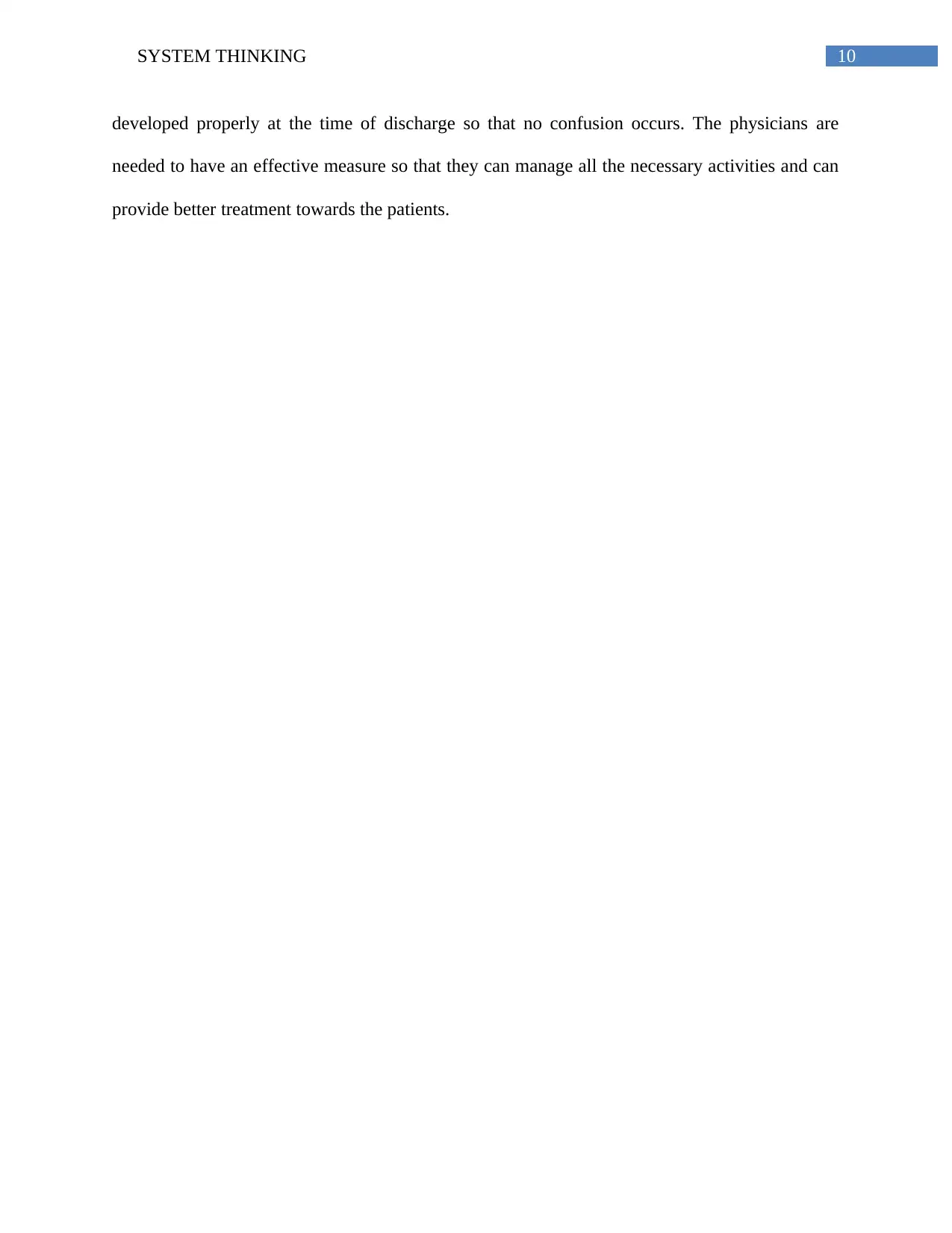
10SYSTEM THINKING
developed properly at the time of discharge so that no confusion occurs. The physicians are
needed to have an effective measure so that they can manage all the necessary activities and can
provide better treatment towards the patients.
developed properly at the time of discharge so that no confusion occurs. The physicians are
needed to have an effective measure so that they can manage all the necessary activities and can
provide better treatment towards the patients.
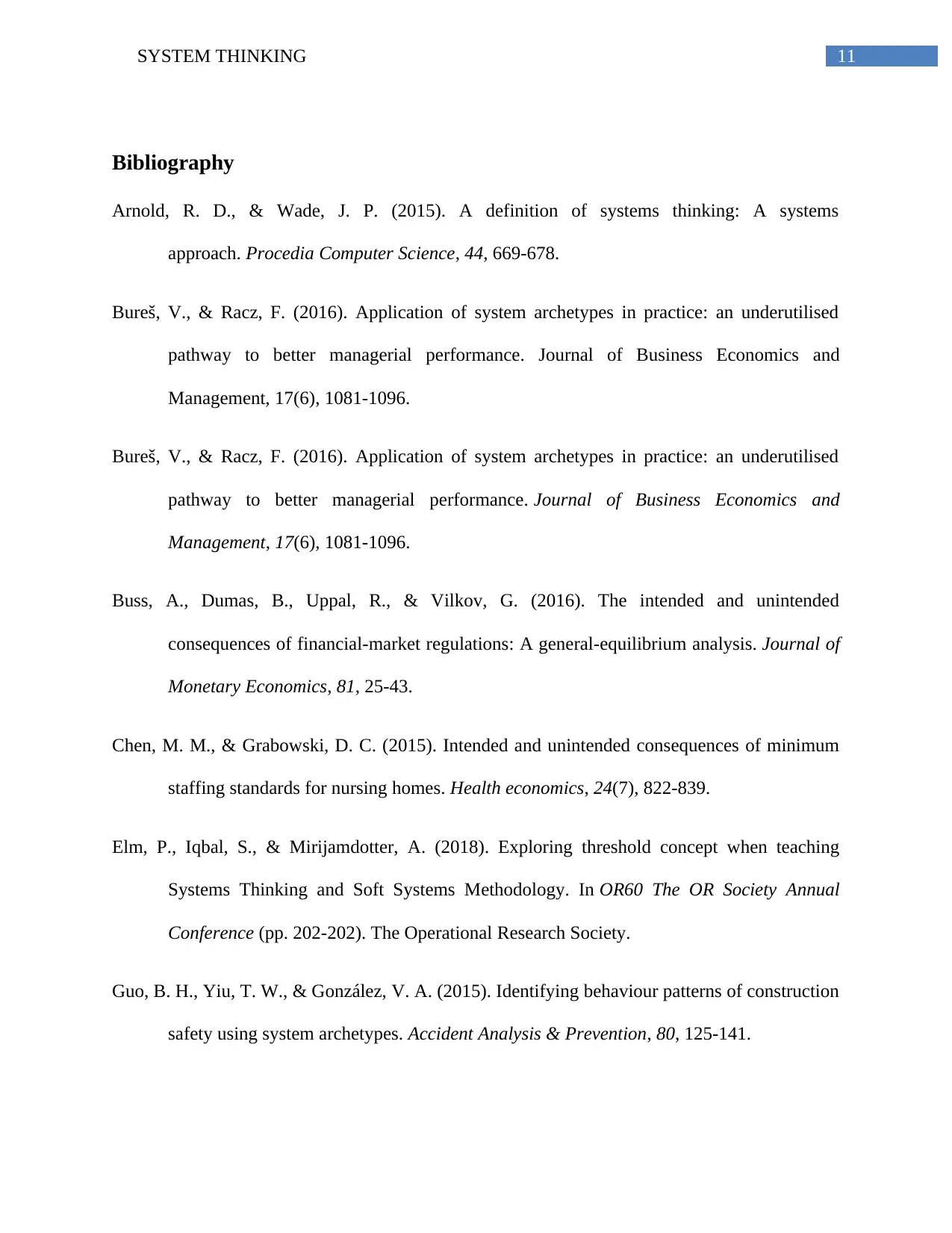
11SYSTEM THINKING
Bibliography
Arnold, R. D., & Wade, J. P. (2015). A definition of systems thinking: A systems
approach. Procedia Computer Science, 44, 669-678.
Bureš, V., & Racz, F. (2016). Application of system archetypes in practice: an underutilised
pathway to better managerial performance. Journal of Business Economics and
Management, 17(6), 1081-1096.
Bureš, V., & Racz, F. (2016). Application of system archetypes in practice: an underutilised
pathway to better managerial performance. Journal of Business Economics and
Management, 17(6), 1081-1096.
Buss, A., Dumas, B., Uppal, R., & Vilkov, G. (2016). The intended and unintended
consequences of financial-market regulations: A general-equilibrium analysis. Journal of
Monetary Economics, 81, 25-43.
Chen, M. M., & Grabowski, D. C. (2015). Intended and unintended consequences of minimum
staffing standards for nursing homes. Health economics, 24(7), 822-839.
Elm, P., Iqbal, S., & Mirijamdotter, A. (2018). Exploring threshold concept when teaching
Systems Thinking and Soft Systems Methodology. In OR60 The OR Society Annual
Conference (pp. 202-202). The Operational Research Society.
Guo, B. H., Yiu, T. W., & González, V. A. (2015). Identifying behaviour patterns of construction
safety using system archetypes. Accident Analysis & Prevention, 80, 125-141.
Bibliography
Arnold, R. D., & Wade, J. P. (2015). A definition of systems thinking: A systems
approach. Procedia Computer Science, 44, 669-678.
Bureš, V., & Racz, F. (2016). Application of system archetypes in practice: an underutilised
pathway to better managerial performance. Journal of Business Economics and
Management, 17(6), 1081-1096.
Bureš, V., & Racz, F. (2016). Application of system archetypes in practice: an underutilised
pathway to better managerial performance. Journal of Business Economics and
Management, 17(6), 1081-1096.
Buss, A., Dumas, B., Uppal, R., & Vilkov, G. (2016). The intended and unintended
consequences of financial-market regulations: A general-equilibrium analysis. Journal of
Monetary Economics, 81, 25-43.
Chen, M. M., & Grabowski, D. C. (2015). Intended and unintended consequences of minimum
staffing standards for nursing homes. Health economics, 24(7), 822-839.
Elm, P., Iqbal, S., & Mirijamdotter, A. (2018). Exploring threshold concept when teaching
Systems Thinking and Soft Systems Methodology. In OR60 The OR Society Annual
Conference (pp. 202-202). The Operational Research Society.
Guo, B. H., Yiu, T. W., & González, V. A. (2015). Identifying behaviour patterns of construction
safety using system archetypes. Accident Analysis & Prevention, 80, 125-141.
⊘ This is a preview!⊘
Do you want full access?
Subscribe today to unlock all pages.

Trusted by 1+ million students worldwide
1 out of 13
Related Documents
Your All-in-One AI-Powered Toolkit for Academic Success.
+13062052269
info@desklib.com
Available 24*7 on WhatsApp / Email
![[object Object]](/_next/static/media/star-bottom.7253800d.svg)
Unlock your academic potential
Copyright © 2020–2025 A2Z Services. All Rights Reserved. Developed and managed by ZUCOL.




